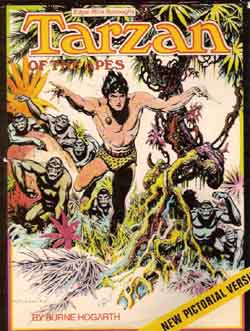
By Burne Hogarth, with text by Edgar Rice Burroughs (Hamlyn)
ISBN: 0-600-38689-9
Here’s another strong candidate for the title of first Graphic Novel, adapting half of the landmark popular classic. Burne Hogarth drew the Tarzan Sunday newspaper strip after Hal Foster left to create Prince Valiant, and his superb anatomical skill and cinematic design skills revolutionised the action/adventure strip. The modern dynamism of the idealised human figure in comic books can be attributed directly to Hogarth’s pioneering drawing.
When he left the strip he eventually found his way into teaching and produced an invaluable series of art text books such as Dynamic Anatomy and Dynamic Figure Drawing, which influenced a generation of aspiring and wannabe pencillers. I can see my own copies from where I sit typing this.
In the early 1970s he was lured back to the realm of the legendary Lord Greystoke, and produced two magnificent volumes of graphic narrative in the dazzling style that had captivated audiences nearly forty years previously. Large bold panels, vibrantly coloured, with blocks of Burroughs’ original text, leap out at the reader in a riot of hue and motion as they tell the triumphant, tragic tale of the orphaned scion of the British nobility raised to awesome manhood by the Great Apes of Africa.
I suspect this book is criminally out of print – certainly my internet searches couldn’t locate a copy less than twenty-five years old. But until some publisher wises up, I can’t think a better example of narrative art for the dedicated aficionado to go hunting for.
Bon Chance, Mes Braves!
© 1972 Edgar Rice Burroughs Incorporated. All Rights Reserved.

I’ve got a copy of this, but I’ve never found — nor even seen — the second volume.
Hogarth’s style is interesting, but very stylized and mannered. Apparently, he was a bit of a pain to know and his teaching methods were not so much intended to teach you how to draw, per se, they were to teach how to draw like him!
His Dynamic Figure Drawing book is essential, as is, probably, the Dynamic Anatomy one. The others, rather less so.
He was indeed quite a character, and certainly not the only artist to believe in a Right way and a Wrong way to draw.
Unfortunately, in many ways diversity of style and especially modern technology do mean that the basic skills can be fudged or avoided…
I’d hate for artists to slip through the way too many adults have missed learning to read…
Win